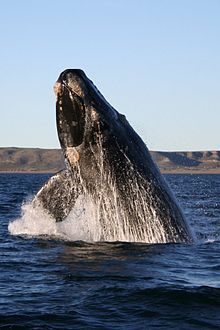Right whale
The right whales (Eubalaena spp.), also known as the black whales are baleen whales with bow-shaped lower jaw and a head that is up to one-quarter of the body length. The head is hairier than most whales; up to 300 hairs are found on the tip of the lower jaw and 100 are on the upper jaw. There are also callosities (a series of horny growths) behind the blowhole, on the chin, above the eyes, on the lower lip, and on the rostrum (the beak-like upper jaw).
| Right whales[2] Temporal range: Miocene–recent
| |
|---|---|

| |
| Southern right whale breaching | |

| |
| Size compared to an average human | |
| Scientific classification | |
| Domain: | Eukaryota |
| Kingdom: | Animalia |
| Phylum: | Chordata |
| Class: | Mammalia |
| Order: | Artiodactyla |
| Infraorder: | Cetacea |
| Family: | Balaenidae |
| Genus: | Eubalaena Gray, 1864 |
| Type species | |
| Eubalaena australis Desmoulins, 1822
| |
| Species | |
| |

| |
E. glacialis ranges E. australis range E. japonica range
| |
| Synonyms | |
| |
Description
changeRight whales are similar to bowhead whales, but smaller. These whales are rich in blubber and have 2 blowholes. The eyes are very small and lips are large. Right whales were named by whalers who considered them the "right" whales to hunt, since they were rich in blubber, they were easy to catch (they are relatively slow swimmers) and they floated after being killed.
History
changeHunters needed the right whale's blubber for meat, because blubber could be boiled to make oil. The right whale's name came from hunters, who thought that they were the "right" whales to hunt. This was because they had lots of blubber. They were also easy to catch (because they were relatively slow swimmers) and they floated on the surface of the water after being killed. Because of these things, right whales are the most endangered of the great whales.
References
change- ↑ "Fossilworks". Archived from the original on 2021-01-15. Retrieved 2021-03-03.
- ↑ Mead, J.G.; Brownell, R. L. Jr. (2005). "Order Cetacea". In Wilson, D.E.; Reeder, D.M (eds.). Mammal Species of the World: A Taxonomic and Geographic Reference (3rd ed.). Johns Hopkins University Press. pp. 723–743. ISBN 978-0-8018-8221-0. OCLC 62265494.
- ↑ Bisconti M, Lambert O, Bosselaers M. (2017) Revision of “Balaena” belgica reveals a new right whale species, the possible ancestry of the northern right whale, Eubalaena glacialis, and the ages of divergence for the living right whale species. PeerJ 5:e3464 https://doi.org/10.7717/peerj.3464
- ↑ Reilly, S.B.; Bannister, J.L.; Best, P.B.; Brown, M.; Brownell, R.L. Jr.; Butterworth, D.S.; Clapham, P.J.; Cooke, J.; Donovan, G.P.; Urbán, J.; et al. (2008). "Eubalaena glacialis". IUCN Red List of Threatened Species. 2008. Retrieved 30 September 2012.
- ↑ Reilly, S.B.; Bannister, J.L.; Best, P.B.; Brown, M.; Brownell, R.L. Jr.; Butterworth, D.S.; Clapham, P.J.; Cooke, J.; Donovan, G.P.; Urbán, J.; et al. (2008). "Eubalaena japonica". IUCN Red List of Threatened Species. 2008. Retrieved 30 September 2012.
- ↑ Kimura, T.; Narita, K. (2007). "A new species of Eubalaena (Cetacea: Mysticeti: Balaenidae) from the Gonda Formation (latest Miocene-early Pliocene) of Japan". Bulletin of the Gunma Museum of Natural History. 11: 15–27.